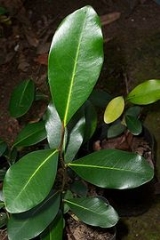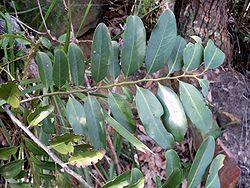
Diospyros australis
Encyclopedia
Diospyros australis is the most southerly of the group of some 450 ebonies and persimmons
. It is a shrub or small tree growing in rainforest
s of seaward eastern Australia
. The habitat is in a variety of different rainforest forms, though not often seen in the cool temperate rainforests. The range of natural distribution is from Durras Lake (35° S) near Batemans Bay in south east New South Wales
, to Atherton
(17° S) in tropical Queensland
.
Common names include Black Plum and Yellow Persimmon. "Grey Plum", sometimes used for this species, usually denotes its northern relative D. pentamera.
Junior synonyms of D. australis are:
 An attractive small tree, rarely reaching a height of 20 metres and a trunk diameter of 25 cm (10 in). The yellow tinged foliage and black berries make identification relatively easy.
An attractive small tree, rarely reaching a height of 20 metres and a trunk diameter of 25 cm (10 in). The yellow tinged foliage and black berries make identification relatively easy.
The base of the tree is not flanged or buttressed. Bark on the cylindrical trunk is grey or black, with wrinkles, bumps and lines. Leaves are yellow or yellow-green underneath with a prominent yellow mid vein. Leaves alternate, smooth edged, elliptical or oblong 4 to 10 cm (4 in) long. Leaf stalks 2 to 5 mm long.
Flowers appear between October and December, being creamy green and four petalled. Female flowers being larger than male flowers.
The fruit matures in the months of February to July, being a shiny black berry, elliptical in shape, 12 to 20 mm in length. Around the base of the berry is a four or sometimes five lobed green calyx
. A single seed is in each fruit, surrounded by edible purple aril
.
Germination from fresh seed is slow, but reliable. After three months, the majority of seeds should germinate.
Its edible berries are used in bushfood
.
Diospyros
Diospyros is a genus of about 450–500 species of deciduous and evergreen trees. The majority are native to the tropics, with only a few species extending into temperate regions. They are commonly known as ebony or persimmon trees...
. It is a shrub or small tree growing in rainforest
Rainforest
Rainforests are forests characterized by high rainfall, with definitions based on a minimum normal annual rainfall of 1750-2000 mm...
s of seaward eastern Australia
Australia
Australia , officially the Commonwealth of Australia, is a country in the Southern Hemisphere comprising the mainland of the Australian continent, the island of Tasmania, and numerous smaller islands in the Indian and Pacific Oceans. It is the world's sixth-largest country by total area...
. The habitat is in a variety of different rainforest forms, though not often seen in the cool temperate rainforests. The range of natural distribution is from Durras Lake (35° S) near Batemans Bay in south east New South Wales
New South Wales
New South Wales is a state of :Australia, located in the east of the country. It is bordered by Queensland, Victoria and South Australia to the north, south and west respectively. To the east, the state is bordered by the Tasman Sea, which forms part of the Pacific Ocean. New South Wales...
, to Atherton
Atherton, Queensland
Atherton is a town on the Atherton Tablelands of Far North Queensland, Australia. At the 2006 census, Atherton had a population of 7,068.-Roads:...
(17° S) in tropical Queensland
Queensland
Queensland is a state of Australia, occupying the north-eastern section of the mainland continent. It is bordered by the Northern Territory, South Australia and New South Wales to the west, south-west and south respectively. To the east, Queensland is bordered by the Coral Sea and Pacific Ocean...
.
Common names include Black Plum and Yellow Persimmon. "Grey Plum", sometimes used for this species, usually denotes its northern relative D. pentamera.
Junior synonyms of D. australis are:
- Cargillia australis R.Br.
- Diospyros cargillia F.Muell.
- Diospyros microcarpa Gürke
- Maba cargilia F.Muell.
Description

The base of the tree is not flanged or buttressed. Bark on the cylindrical trunk is grey or black, with wrinkles, bumps and lines. Leaves are yellow or yellow-green underneath with a prominent yellow mid vein. Leaves alternate, smooth edged, elliptical or oblong 4 to 10 cm (4 in) long. Leaf stalks 2 to 5 mm long.
Flowers appear between October and December, being creamy green and four petalled. Female flowers being larger than male flowers.
The fruit matures in the months of February to July, being a shiny black berry, elliptical in shape, 12 to 20 mm in length. Around the base of the berry is a four or sometimes five lobed green calyx
Sepal
A sepal is a part of the flower of angiosperms . Collectively the sepals form the calyx, which is the outermost whorl of parts that form a flower. Usually green, sepals have the typical function of protecting the petals when the flower is in bud...
. A single seed is in each fruit, surrounded by edible purple aril
Aril
An aril is any specialized outgrowth from the funiculus that covers or is attached to the seed. It is sometimes applied to any appendage or thickening of the seed coat in flowering plants, such as the edible parts of the mangosteen and pomegranate fruit, the mace of the nutmeg seed, or the...
.
Germination from fresh seed is slow, but reliable. After three months, the majority of seeds should germinate.
Its edible berries are used in bushfood
Bushfood
Bushfood traditionally relates to any food native to Australia and used as sustenance by the original inhabitants, the Australian Aborigines, but it is a reference to any native fauna/flora that is used for culinary and/or medicinal purposes regardless of which continent or culture it originates...
.

